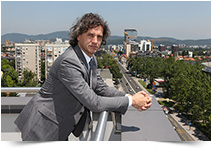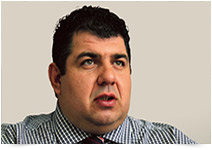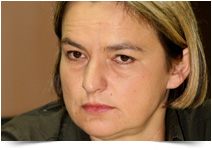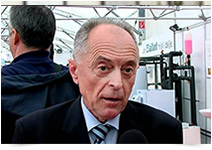Energy Department Dedicates Clean Energy Research Center
 |

The ESIF on NREL's campus is the
nation’s first major research facility focused on clean energy grid
integration and wide-scale deployment.
Credit: Dennis Schroeder, NREL
|
The Energy Department on
September 11 dedicated the nation’s first major research facility
focused on clean energy grid integration and wide-scale deployment.
Located on the campus of the National Renewable Energy Laboratory
(NREL), the new Energy Systems Integration Facility (ESIF) will help
manufacturers, utilities, and public and private sector researchers
overcome the challenges of integrating clean energy and energy
efficiency technologies into today's energy infrastructure. The Energy
Department also unveiled Peregrine—the newest Energy Department
supercomputer. NREL collaborated with HP and Intel to develop an
innovative warm-water, liquid-cooled supercomputer. Peregrine resides in
the new ESIF data center, designed to be the world’s most
energy-efficient high performance computing data center.
President Obama has set a goal
to double renewable electricity generation once again by 2020. Seamless
and efficient grid integration will help meet this ambitious target and
make clean energy technologies even more affordable. To that end, ESIF
will tackle generation, transmission, distribution, and end-use
challenges to advance renewable energy, electric vehicles, energy
storage batteries, microgrids, and next-generation building
technologies.
As one of the first ESIF
projects, the Energy Department, NREL, and Toyota Motor
Engineering&Manufacturing, North America, announced on September 11 a
collaborative research effort to integrate plug-in electric vehicles
into the power grid. Scientists and engineers at ESIF and NREL’s Vehicle
Testing and Integration Facility will use 20 Prius plug-in hybrid
electric vehicles from Toyota to develop and explore ways to prepare
grid operators and energy infrastructure to accommodate the growing U.S.
electric vehicle fleet. See the Energy Department press release.
The ESIF also made news on
September 12 with a one-of-its-kind national secure data center
dedicated to the independent analysis of advanced hydrogen and fuel cell
technologies. The National Fuel Cell Technology Evaluation Center
(NFCTEC) allows industry, academia, and government organizations to
submit and review data gathered from projects to advance cost-effective
fuel cell technology. NFCTEC will also help accelerate the
commercialization of fuel cell technologies by strengthening data
collection from fuel cell systems and components operating under
real-world conditions, and by providing analyses of these detailed data
that can be compared to technical targets. See the Energy Department Progress Alert.
Energy Department, EPA Release Used-Vehicles Fuel Economy Tool
The Energy Department and the
Environmental Protection Agency (EPA) on September 12 released a new
label that features EPA fuel economy estimates and carbon dioxide
estimates for used vehicles sold in the United States since 1984.
Consumers may create the new label electronically using a new tool on
FuelEconomy.gov. This electronic graphic can be downloaded and included
in online advertisements on the web, while the paper label may be
printed and affixed to the vehicle window. Because a vehicle's fuel
economy changes very little over a typical 15-year life with proper
maintenance, the original EPA fuel economy estimate remains the best
indicator of a used vehicle's average gas mileage.
The Obama Administration has
taken steps to improve the fuel efficiency of vehicles sold in the
United States, establishing the toughest fuel economy standards for
passenger vehicles in U.S. history. These standards are expected to save
consumers $1.7 trillion at the pump—or more than $8,000 in costs over
the lifetime of each vehicle—and eliminate six billion metric tons of
carbon pollution.
All new vehicles now include a
comprehensive fuel economy and environmental window sticker from the
EPA, including passenger vehicles that meet the new fuel economy
standards. With the FuelEconomy.gov tool, used vehicle sellers can
provide potential buyers with fuel economy information that they can
easily understand. Last year, more than 40 million used cars were sold
in the United States—roughly three times the number of new cars sold in
2012. See the Energy Department Progress Alert and the FuelEconomy.gov website.
University of Maryland Wins Appliance Design Competition
The Energy Department announced
September 10 that the University of Maryland won the second annual Max
Tech and Beyond design competition for ultra-low energy use appliances
and equipment for the second year in a row. The team developed a heat
pump clothes dryer that is nearly 59% more efficient than a traditional
electric dryer. The winning prototype will be on display at this year's
U.S. Department of Energy Solar Decathlon in Irvine, California. With a
comprehensive business plan, Ohio State University placed second in the
challenge for its hybrid air/water conditioner that can achieve nearly a
73% energy cost savings over a conventional central air conditioning,
dehumidification, and ventilation system.
The Max Tech and Beyond
competition challenges university teams to go beyond the current "max
tech," or maximum technology performance levels, by exploring new design
concepts that could become the next generation of ultra-low energy use
appliances and equipment. Funded by the Energy Department's Building
Technologies Office and managed by Lawrence Berkeley National
Laboratory, the competition encourages participating students to connect
with U.S. manufacturers and license their designs after successful
demonstration. In total, eight teams spent the 2012-2013 academic year
in their respective laboratories, fine-tuning their innovative
technologies and gaining valuable knowledge of energy efficiency. These
efforts helped to produce ultra-efficient prototypes for demonstration
and deployment in the global clean energy market. See the Energy
Department Progress Alert.
USDA Awards $15 Million for Advanced Biofuels
The U.S. Department of
Agriculture (USDA) announced on September 12 that it is making more than
$15 million in investments to support the production of advanced
biofuel. USDA is funding 188 producers through the Advanced Biofuel
Payment Program.
For example, Riverview, LLP, a
Minnesota-based company, will use a payment to support a project that
produces electricity from two anaerobic digesters which use manure from
two of the company's dairy operations to produce electricity. During the
last quarter of 2012, the anaerobic digesters produced almost 4.9
million kilowatt hours of electricity, enough to power more than 400
homes a year. And American Biodiesel, Inc. in California will receive
payment for its quarterly production of biodiesel from a variety of
sources, including canola and soybean oil. The biodiesel reduces
emissions and is primarily used as an alternative to diesel fuel. See
the USDA press release. |
Solar Decathlon 2013: Designing the Houses of Today
Designing an energy-efficient,
solar-powered house for the Solar Decathlon is like solving a riddle
that has more than one right answer. Instead of just thinking about
building materials and cost in the design process, teams have to
consider a myriad of factors to create a winning house.
While the design process never
officially ends, the teams spend more than a year focusing on the design
before breaking ground on their houses. Early on in the process, they
select a target client for their house—one of the biggest impacts on
their final design—and decide how they will transport their house to the
competition site. The teams also have to make sure their designs meet
contest criteria and rules—such as staying within a specified square
footage, not exceeding solar array dimensions, and being accessible to
visitors with disabilities. Throughout the process, the teams are
required to submit construction plans and documentation, which are
reviewed by the Solar Decathlon organizers for building code and rules
compliance. Once their designs are complete, the teams can start
constructing their houses. Visit the U.S. Department of Energy Solar Decathlon 2013 website and for the complete story, read the Energy Blog.
EPA Kicks Off Energy Star National Building Competition
The U.S. Environmental Protection Agency (EPA)
on August 20 launched the 2013 Energy Star National Building
Competition: Battle of the Buildings. Teams from more than 3,000
buildings across the country are competing to see who can most reduce
their buildings’ energy use. In support of President Obama’s Climate
Action Plan, which calls for buildings to cut waste and become at least
20% more energy efficient by 2020, the competition specifically targets
wasted energy in commercial buildings and motivates businesses to
improve energy efficiency, reduce harmful carbon pollution, and save
money.
More than 25 different types of commercial
buildings are facing off in this year’s Energy Star National Building
Competition, representing all 50 states, the District of Columbia,
Puerto Rico, and the U.S. Virgin Islands. The diverse field of
competitors includes the Hard Rock Hotel in Orlando, Florida; a Catholic
cathedral and rectory in Seattle, Washington; New York City’s historic
100 Park Avenue building; and Busch Stadium—home of the St. Louis
Cardinals in St. Louis, Missouri. Competitors measure and track their
buildings’ monthly energy consumption using Portfolio Manager, EPA's
Energy Star online energy measurement and tracking tool, and work over
the year to cut energy waste through improvements that range from
equipment replacement to changes in occupant behavior. Midpoint
“weigh-in” results will be posted in December, with the winner announced
in April 2014.
The number of participants in the Battle of the
Buildings has increased from 14 buildings in 2010—the competition’s
first year—to more than 3,200 buildings in 2013. Altogether, last year’s
competitors cut their energy costs by more than $50 million and reduced
annual greenhouse gas emissions equal to the electricity used by more
than 43,000 homes. Commercial buildings in the United States are
responsible for approximately 20% of both the nation’s energy use and
greenhouse gas emissions at a cost of more than $100 billion annually.
See the EPA press release and the Battle of the Buildings website.
Renewable Energy Provided Nearly 50% of 2012 U.S. Added Capacity
Renewable energy sources in the United States
accounted for nearly 50% of U.S. electric capacity added in 2012,
according to a new report. Wind deployment added a record 13,124
megawatts (MW) of capacity, and solar added 3,313 MW of capacity,
according to the latest edition of the Ernst & Young report on U.S.
renewable energy attractiveness indices. The report highlights trends in
U.S. renewable investment and ranks the states in terms of their
attractiveness for clean technology investment. The indices provide
scores for state renewable energy markets, renewable energy
infrastructures, and their suitability for individual technologies, and
are updated on a biannual basis.
California led the nation in the report's
measure of all renewable energy attractiveness, followed by Hawaii,
Texas, Colorado, and Nevada. Texas was the leader in the actual
installed wind base. See the Ernst & Young press release and the latest indices report.
EPA, NREL Screen Contaminated Sites for Renewable Energy Potential
The U.S. Environmental Protection Agency (EPA)
on August 5 updated its RE-Powering mapping and screening tool, which
will now provide preliminary screening results for renewable energy
potential at 66,000 contaminated lands, landfills, and mine sites across
the country. Working in collaboration with the Energy Department’s
National Renewable Energy Laboratory (NREL), RE-Powering developed
screening criteria for solar, wind, biomass, and geothermal potential at
various levels of development.
The RE-Powering America’s Land Initiative,
started by EPA in 2008, encourages development of renewable energy on
potentially contaminated land, landfills, and mine sites when it is
aligned with a community’s vision for the site. Pulling from EPA
databases of potentially and formerly contaminated lands, as well as
partnering with state agencies from California, Hawaii, New Jersey, New
York, Oregon, Pennsylvania, Virginia, and West Virginia, the RE-Powering
Initiative expanded the universe of sites from 24,000 to more than
66,000.
The updated tool provides insight into the
significant potential for renewable energy generation on contaminated
lands and landfills nationwide. For solar energy alone, EPA identified
more than 10,000 contaminated sites with the potential to install a
300-kilowatt solar array or greater. Based on mapped acreage, these
sites could cumulatively host solar energy systems that capture greater
than 30 times more solar energy than all renewable energy systems
operating in the United States today. See the EPA press release and the RE-Powering mapping tool.
USDA Awards $21 Million to Renewable and Energy Efficiency Projects
The U.S. Department of Agriculture (USDA) on
August 15 announced more than $21 million in funding for 631 projects
across the nation that will help agricultural producers and rural small
businesses reduce their energy consumption and costs, use renewable
energy technologies in their operations, and conduct feasibility studies
for renewable energy projects. Farmers, ranchers, business owners, and
agriculture producers in 42 states, the U.S. Virgin Islands, and Puerto
Rico will receive funding. Grants and loans are made through the USDA's
Rural Energy for America Program (REAP).
REAP helps producers reduce energy costs and
increase production efficiency. For example, a family in North Carolina
will use a $7,403 grant to install an energy-efficient geothermal
system. And a nursery in Nevada will use a $12,476 grant to install a
solar photovoltaic system to provide power for its farm and nursery.
Under the terms of REAP, up to 25% of an eligible energy production or
conservation project can be funded through a grant, and additional
support can be provided in the form of a loan. Since the start of the
Obama Administration, REAP has helped fund nearly 7,000 renewable energy
and energy efficiency projects nationwide.
The funding includes almost $300,000 in grants
to 19 agricultural producers and rural businesses to conduct feasibility
studies for renewable energy systems. For example, the Gunnison County
Electric Association, Inc., in Gunnison, Colorado, will receive a $6,739
grant to assess the feasibility of installing a small hydropower
generating plant at the Taylor Reservoir Dam. If built, the plant would
generate 4 megawatts of power. See the USDA press release.
Croatian Center of Renewable Energy Sources (CCRES)
|
 Solarne ploče na krovu sve su češći prizor.
Solarne ploče na krovu sve su češći prizor. S pomoću oznaka energetske učinkovitosti potrošači mogu odabrati proizvode kojima se štedi energija.
S pomoću oznaka energetske učinkovitosti potrošači mogu odabrati proizvode kojima se štedi energija.





























